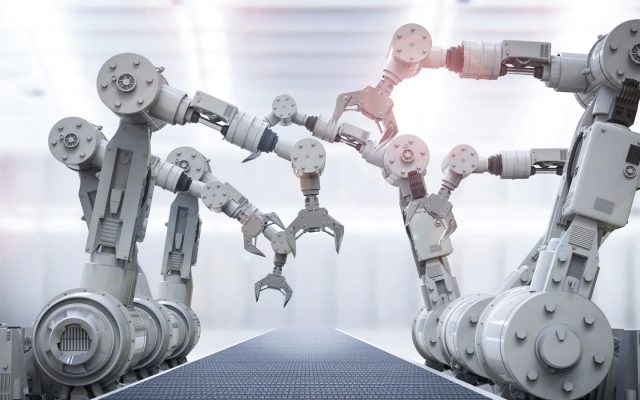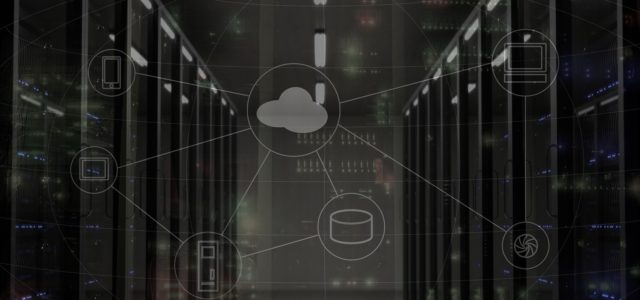Automated systems are now prevalent and have already infiltrated our world and lives; take a look around and you’ll see machines carrying out repetitive tasks or routines without manual intervention. In fact, your Amazon shopping basket can be filled with items that were ‘recommended’ to you by an algorithm monitoring your purchasing decisions.
‘Automation’ and ‘artificial intelligence’ (AI) have both become today’s interchangeable shorthand umbrella terms for robots and machines that provide a means for us to operate in our world more efficiently and effectively. Although both terms cover a wide-ranging spectrum of machinery – from those that put together intricate parts of a car to automated security and fire alarm systems – there are some important differences between artificial intelligence and automation systems.
Automation is the creation of software that is designed to follow pre-programmed rules whilst artificial intelligence is entirely aligned with humanising machines to help stimulate and mimic human intellect. This distinction between the two terms is pivotal to how we can assess and understand both the threats and benefits both pose now and in the future.
Both are driven by data – Automated systems collect data; AI systems seek to ‘understand’ it. Together they are the future of business. They complement one another; automatic data collection working alongside systems that can logically ‘understand’ patterns in the data. Already it is estimated that on average businesses with more than 20% revenue growth are 61% automated compared with those that have neutral or negative growth being only 35% automated (McKinsey & Company).
We have curated the top articles covering the most important areas of AI and Automation to provide a further briefing on how both are shaping our world and have spurred new changes and trends of their own across the economic and business landscape.
Business adoption of AI & automation
- INTELLIGENT AUTOMATION ENTERING THE BUSINESS WORLD
Most of us are used to hearing about the role of robotics in the primary sector where the human element has largely been removed from the production chain and has been replaced by machinery that has taken on back-end repetitive operations (despite not being revenue-generation areas) where high-volume rules-based work is the norm. Today, intelligent automation has already begun entering the business world in the form of newer softwares (Deep machine learning, autonomics, machine and computer vision and natural language processing (NLP)) helping many companies go beyond conventional performance trade-offs to achieve unprecedented levels of efficiency and quality across different areas of their business models.
The scope and extent of how robotic process automation now and in the future can improve process efficiency across different areas of organisations will be dependent upon what is possible with current technology vs with AI. What’s clear is that the benefits of AI are much broader than the cost savings that are implied by the term ‘automation’, namely; faster actions and decisions, better outcomes, greater efficiency, lower costs, greater scale and even product and service innovation.
Read: Intelligent Automation Entering the Business World
- TRADITIONAL INDUSTRIES USING MACHINE LEARNING TO GATHER FRESH BUSINESS INSIGHTS
AI can help reduce some of the base-level functions and roles that every business structures itself around. From the manufacturing sector to financial, legal and healthcare services, every sector has operations that are routine and require few skills – one of the key realities that AI impacts.
In manufacturing, advancement is continuing to be made in relation to monitoring and maintenance of other machinery as well as optimisation of supply-chain operations. In the financial sector, AI machine learning, such as Automated Advisory, has already started to replace predictive analysis methods for gauging financial market trends. Financial companies, especially banks, are also using AI to help in the early detection (and also prevention) of financial fraud, with AI already being considered as the future of financial risk management for lending institutions. In healthcare, AI is becoming the key to leveraging the potential of medical data (Big Data) to help with disease prevention, identification and diagnosis; it will also soon contribute more to R&D and clinical trials, which will reshape the pace and scope of medical research. Additionally, at the micro level, AI-based systems are already helping hospital staff improve their operational workflows.
Read: The top 7 industries with potential for artificial intelligence, 5 industries AI will disrupt in the next 10 years
- MACHINE LEARNING IN BUSINESS
Unlike automation in which a computer software can be programmed using algorithms and rules so it can ‘be intelligent’ and make decisions using sets of rules, exceptions and filters; a subset of AI is ‘machine learning’ which enables systems to autonomously learn and predict outcomes without explicit programming rules. Machine learning essentially teaches computer systems to make decisions by learning from large data sets, which is transforming business models and processes.
But even as the technology advances, companies and organisations are still struggling to take advantage of AI machine learning and failing to strategically implement it in the service of their business goals. AI hysteria has likely not helped in this arena, there seems to be confusion amongst leaders about what machine learning is and what it can do for companies exactly.
Read: A practical guide to machine learning in business
- NATURAL LANGUAGE PROCESSING (NLP) IN BUSINESS
Natural Language Processing (NLP) is another area of AI that we have seen a proliferation of in the consumer space i.e. machines that can analyse and ‘understand’ human interaction and languages – think virtual assistants like Siri on your smartphone, Amazon Alexa and Google Assistant as well as customer service ‘chatbots’ that handle routine customer inquiries over the phone and online.
These involve sentiment and emotion analysis where machines are able to understand the context or intent of a conversation – a major tool that businesses will begin to adopt to help them understand the needs of their customers more and improve their social branding strategies. In fact, by 2025, global revenue for these types of software will reach around $3.5 billion (Tractica, 2018)
NLP has already made great strides with Alibaba’s AI deep-learning Model scored better than humans in a Stanford University reading comprehension test in January 2018.
Read: 5 major AI trends of 2018
- ECONOMIC POTENTIAL OF ADVANCED AI TECHNIQUES
The practical applications and the economic potential of advanced AI techniques across industries and business functions are becoming clearer. Traditional analytics and newer ‘deep learning’ (AI) techniques are solving a broad range of problems in companies and organisations across the economy; because of the wide applicability of AI across the economy, the types of use cases with the greatest value potential vary by sector.
AI’s deep learning techniques can provide a step up from more conventional analytics techniques, i.e. regression analysis and classification techniques, being used currently. The greatest potential is how it can create value by supplementing current analytics with neural network techniques that could provide both higher performance and generate additional insights; this is true for 69 percent of the AI use cases identified in a study of 400 cases (below).
Read: Notes from the AI frontier: Insights from hundreds of use cases
How will AI & automation affect jobs, skills and wages?
- HISTORICAL TRENDS IN TECHNOLOGY AND EMPLOYMENT
It is widely understood that automation will impact employment; in fact, this topic has been an historical staple we have seen once a generation where panic arises around technology destroying jobs. In the 19th century cloth making was transformed by technology and in the 20th century the making of cars was too. Entirely new industries led to cheaper goods and increasing demands for them, which highlights that as productivity output increases with technology, so does the demand for increased levels of output. In reality the loss of jobs created by new technology has historically led to higher incomes and an overall increase in total employment, as jobs created are those that we wouldn’t have imagined before the technology existed.
Read: What can history teach us about technology and jobs?
- AUTOMATION ANXIETY
Economists are already concerned about job polarisation, where middle-skill jobs (e.g. manufacturing) are falling in number whilst both low-skill and high-skill jobs are expanding. This effectively will split the workforce into two main clusters: one group that does non-routine, high-paid, skilled work (e.g. such as architects and senior managers), whilst the other group does low-paid, unskilled work (e.g. cleaning). To add to this worry, many believe that AI and automation are “blind to the colour of your collar”; what determines vulnerability to automation is not so much whether the work concerned is manual or white-collar but whether or not it is routine.
In fact, some AI and automation experts are already warning us about the threat of a “jobless future”, pointing out that most jobs can be broken down into a series of routine tasks, of which an increasing amount can be done by AI and automated machines. Other economists are positing that because in the past technology eventually created more jobs than it destroyed, in practice, whilst automation and AI can perform specific tasks more quickly or cheaply, they will likely increase the demand for human workers to start doing the other tasks around it that have not been automated.
Read: Automation and anxiety
- CAN MACHINES COMPLETELY REPLACE JOBS OR JUST TASKS?
There is somewhat of a guessing game around which jobs will or won’t be replaced by machines, some research (below) highlights that the story is a lot more nuanced than initially perceived. Automation will eradicate only a small number of jobs in the next decade; it will impact parts of nearly all jobs to different degrees – both of which are dependent upon the types of tasks each occupation entails. Sectors which involve a large amount of knowledge work, i.e. healthcare and finance, will be transformed by the technical feasibility of robotics and machine learning, whilst others may not (yet).
Still, though, the bottom line is that the technical potential for automation differs dramatically across sectors and activities.
Read: Where machines can replace humans and where they can’t (yet)
- HOW JOBS WILL RESPOND TO AUTOMATION
Whilst it is clear automation is changing the nature of work, the extent to which robots will take jobs is still far-off. The current rhetoric is that low-paying jobs are in danger whilst university-educated professionals will remain relatively unscathed.
However, new research by MIT shows that this is largely based on a conventional understanding that wage and education are the most important variable when considering predictors of job evolution; a more nuanced understanding is that the level of threat of AI and automation on a given profession is hugely conditional on the type of value employees deliver and the actual skills they employ to deliver it.
Read: Four ways jobs will respond to automation
- NEW HIGH-QUALITY JOBS WITH AI & AUTOMATION
Although there is still a lack of consensus in the analyses on the impact of AI on employment now and in the future; a strong case is that AI and automation can be leveraged to create new high-quality jobs, which will greatly improve job quality and the productivity of the existing global workforce. This is because AI and automation are expected to augment existing jobs and help generate a range of wholly new tasks across all sectors in the global economy. This ranges from developing apps and piloting drones to remote patient observation in healthcare.
Whilst this indeed opens up new opportunities and livelihood possibilities, it is equally apparent that the fourth industrial revolution will certainly reduce the demand for human workers for certain work tasks. The World Economic Forum’s analysis (below) shows that the increase in demand for new roles will offset the decrease in demand for others. However, these net gains are not a foregone conclusion.
Read: The future of jobs
- IMPACT OF AI AND AUTOMATION ON HIGH-WAGE JOBS
A sizeable amount of activities performed by those in the highest-paid occupations (e.g. senior executives, financial planners and physicians) can be automated simply by adapting current technology potentials using machine programming. In fact, tasks and activities that take up over 20% of CEO’s time at work could easily be automated; for example, analysing reports and data to inform operational decisions, delegating and preparing employee assignments or even reviewing status reports are likely to be replaced by a machine.
Interestingly, other lower-paying jobs (e.g. carers and landscapers) actually have a lower percentage of tasks and activities that can be taken over by the technology available today.
Read: Four fundamentals of workplace automation
- THE FUTURE OF WORK IS HUMAN-ROBOT COLLABORATION
Whilst it is clear that AI and automation will disrupt companies and industries across the world over the next five to ten years as these technologies start to permeate; if we understand the actual effects and work to adapt business processes then the business world can truly take advantage of them and generate new wealth and benefits.
The reality is that in most cases AI (especially machine learning) can certainly do some tasks in an occupation but not all tasks. This means most jobs will be partly affected by machine learning, but humans will have tasks they need to continue to do alongside new ones. Employees don’t need to lose jobs with the growing presence of robots that alleviate menial, routine and physically-strenuous tasks; a likely scenario will be human-robot collaboration, where robots that are purpose-built for collaboration, also known as co-bots, will create increasing opportunities for workers to free up their time and work on more complex tasks. So whilst some sectors will face displacement, it is predicted by some to be a small percentage of the potential growth predicted.
Read: AI’s impact on the future of work
- HOW DO WE CREATE MEANINGFUL WORK IN THE AGE OF AUTOMATION?
With the view that automation will displace many jobs over the next decade or so whilst new jobs will likely be created too; it’s becoming clear that jobs of the future will need and use different skills and many have higher educational requirements. The questions are now shifting towards how we can start now to retrain workers for the new world of work and what the shifts will mean in reality for jobs and wages. Ultimately, the question is not about if there will be jobs, it’s about whether today’s workers, given their existing skillsets and capabilities, will be qualified to get the jobs that will actually be there.
The growth of jobs predicted will strongly depend on the country at hand; in developing economies, which are still growing rapidly, there is a trend of job growth across all occupations and thus there is still rising demand for labour. In developed economies the story will be slightly different; the impact of AI and automation over the next decade or so will be much higher because of the different wage structure. Still though, in both cases, the world is in uncharted territory and the greatest challenge will be about helping today’s workers be ready to adapt for the future transitions and new requirements by introducing lifelong learning mentalities.
Read: How will automation affect jobs and wages?
- POSSIBLE SCENARIOS FOR EMPLOYMENT GROWTH
Research (below) has already started to observe and analyse not only all occupations but also their corresponding activities – of which there are many – to form a better understanding of the pace at which different jobs and tasks could potentially be usurped by adopting technologies that either already exist today or those that are likely to be developed by 2030.
The implications of other catalysts on whether the demand for human labour increases (net of those activities that might be automated) is also considered e.g. caring for ageing societies, energy efficiency and climate change challenges, the production of goods and services for the growing consuming class (especially in developing economies) and investment in technology and infrastructure.
Because the workforce transitions ahead will be significant, what is clear from the research is that businesses and governments must seize opportunities to boost job creation for labour markets to continue to function well in the event of rapid automation adoption. If workforce transition to new occupational categories and new skills is too slow then dangerous levels of unemployment could occur which will significantly dampen wage growth.
Ultimately, the implications of AI and automation is less about a ‘jobs lost, jobs gained’ scenario and more about a ‘jobs lost, jobs changed, jobs gained’ one. Numerous global societal choices will be the determining factor in whether current and future workforce transitions are smooth, or whether unemployment and income inequality rise.
Read: Jobs lost, jobs gained: workforce transitions in a time of automation
- IMPACT OF AI ON ORGANISATIONS: FUTURE PREDICTIONS
With a more complex business environment coming into focus, AI and automation will stimulate a gradual evolution in the job market. Rather than robots ‘taking over’ jobs, new jobs will be offsetting the jobs lost by automation and AI, according to PwC’s report (below) on the future predictions of AI. This means the real result will likely be an impact on the workforce before employment per se.
A useful vantage point will be to look at why organisations will succeed or fail depending on the extent to which they are able to adapt how they work in the face of technology transformation. More precisely, how well they can break down silos that pigeon-hole AI talent and become more collaborative so that an AI-savvy workforce is fostered. 67% of executives say AI will help humans and machines work together to be stronger using both artificial and human intelligence (PwC consumer Intelligence series, 2018).
Read: AI future predictions
AI & automation and Leadership
- MANAGER AND MACHINE: THE NEW LEADERSHIP EQUATION
Even in the presence of AI, humans will still have a comparative advantage when it comes to inspiring a workforce, empathising with customers and talent development. Of course, machines will provide invaluable input in terms of people data-analytics efforts, but actually translating this type of data insight that can resonate with humans within organisations will ultimately require a human touch. Machines and computers can’t walk around and manage people and leaders won’t stimulate and rouse their employees with an algorithm. What’s clear is that the context of AI and automation in the workplace, leaders of the future will need to understand and incorporate small-scale machine-driven results into their decisions.
The reality is that there will be a simultaneous growth in the importance of softer leadership skills alongside tech-savviness will boost the complexity and richness of the senior-executive role. For leaders, this means having an ability to remain in a continuous state of uncertainty and unknowing whilst also filtering and evaluating machine-driven information.
Read: Manager and machine
- AI AND ROBOTIC PROCESS AUTOMATION (RPA) FOR ORGANISATIONAL LEADERS
No matter what term an organization uses to describe automation technology, the goal the same everywhere: leaders must be able to harness the power of digital to elevate the customer journey and drive end-to-end business outcomes. Software robots often referred to as robotic process automation (RPA) systems, have gained considerable ground on this front, welcomed by C-suite executives who are keen to cut costs, improve productivity and gain a competitive advantage.
Today’s leaders must start to: assess the opportunities of automation in their organisation’s process landscape; estimate the benefits of automation on a process-by-process basis, i.e. whether to implement a strategic automation capability within their organisation vs gaining automated outcomes with minimum effort; consider their automation sourcing options to decide which automation partners their organisation should work with to pilot processes; and put together a roadmap for automation journey beyond the initial stages of development, i.e. how automation will grow within their organisation.
Read: A leader’s guide to robotic automation
- THE IMPACT OF AI ON LEADERSHIP AND THE MODERN WORKFORCE
In order to remain competitive, businesses investing in AI must also invest as much in their employees. As AI increases in scale and drives further change, businesses that embrace training and re-skilling current employees will realize tangible benefits. Because AI will bring continuous change, training cannot be a one-time initiative. The most successful organizations will be those that adopt a culture of lifelong learning and facilitate opportunities for staff to continuously develop new skills. Business leaders will also need to evolve their skills to gain a deeper understanding of the technologies that are driving their businesses forward in the years to come.
Read: Impact of AI on business leadership and the modern workforce
- MACHINES ARE TACTICAL, HUMANS ARE CREATIVE AND STRATEGIC
The more technical the work, the more technology will likely accomplish it. In other words, machines skew toward pre-emptive and tactical applications rather than strategic – an area humans still dominate. Because of this, work that requires a high degree of imagination, creative analysis, and strategic thinking is much harder to automate with currently available AI and automation technologies. Jobs that involve managing and developing people (9% automation potential) or those that apply measured and abstract expertise to decision making, planning or creative work (18% automation potential) are therefore much less likely to be eradicated by automation. Ultimately, computers are great at optimizing, but not so great at goal-setting.
Read: The future of human work is imagination, creativity and strategy
- ATTRIBUTES OF AI-DRIVEN LEADERSHIP
The necessary attributes to become an AI-driven leader are mostly logical. These types of leaders ensure they learn about new technologies so that they know what AI is and what it does. They also establish clear business objectives for using AI, i.e. where AI can be used to improve business processes in which ones are worth focussing on. AI-driven leaders also set their AI ambitions to a realistic setting, ensuring that they focus on “quietly but meaningfully improving core operations” that together contribute to major change in their products or services.
Good AI-driven leaders are already preparing and supporting their employees for AI with training programs and are incorporating continuous learning into their business models. These leaders also collaborative in their approach and thereby promote close collaboration across important departments that involve technology. Perhaps most importantly, AI-driven leaders ensure they collect and gather necessary data as this is their most important asset for all their future work involving AI.
Read: AI driven leadership
- AS AI MAKES MORE DECISIONS IMPORTANT LEADERSHIP COMPETENCIES WILL CHANGE
Leadership will not be spared the impact of AI and automation; AI will replace many of the ‘hard’ leadership skills, i.e. processing and handling facts, data and information, and will instead focus the spotlight on ‘soft’ leadership skills, i.e. personality, attitude and behaviours, that are core to helping leaders set a common goal or shared purpose.
When we consider the AI age as a time of intense disruption and rapid ambiguous change, the very core of effective leadership will inevitably change as the ‘soft’ elements of leadership that are needed become clearer. Agility, humility, adaptability, forward-thinking vision and high-level engagement are just some of the qualities that will start to usurp the conventional leadership qualities we’re used to, such as authority, decisiveness and short-term focus.
Read: As AI makes more decisions, the nature of leadership will change
- EMBRACING AI FAST ENOUGH
AI will slowly level the playing fields in the global business landscape as the capabilities once concentrated in a few large organizations will become widely accessible, enabling small competitors to start taking on old industry leaders. This is why, across the board, in companies big and small, successful AI transformations start with having visionary leadership teams who truly understand that AI will create new products, transform their organizations and industries.
This type of revolutionary transition calls for a thoughtful, comprehensive approach. The organisations that are already ahead of the curve with AI are led by far-seeing but realistic leaders who position and implement deep thinking machines and technology as part of a broad strategic effort to ride through the fourth industrial revolution’s wave. In practice, leaders that understand the importance of embracing AI fast enough ensure that innovation drives their organisational cultures whilst also ensuring enough investment is made in R&D. Forward-thinking leaders are already building their company’s data processing capabilities and leveraging their current data whilst also making room now to store Big Data and sophisticated algorithms in the near future.
What’s clear is that purchasing AI software and implementing some new technology and data management systems will therefore not suffice. Organizations will need to be reorganised to tackle the challenge of AI and automation. Whilst it is still early days, AI and automation are already making changes to customer service, product design and operational efficiency; bigger and greater rewards and benefits will be there for organisations that make the right moves today.
Article by channel:
Everything you need to know about Digital Transformation
The best articles, news and events direct to your inbox
Read more articles tagged: AI, Automation, Featured






